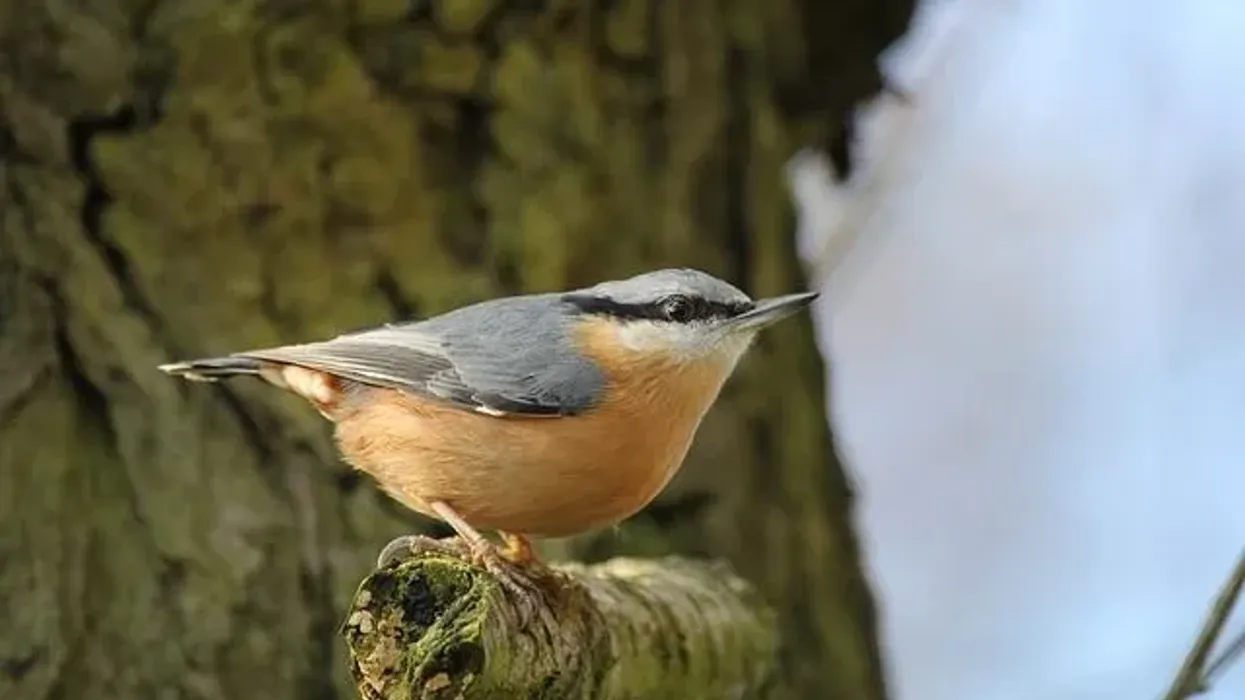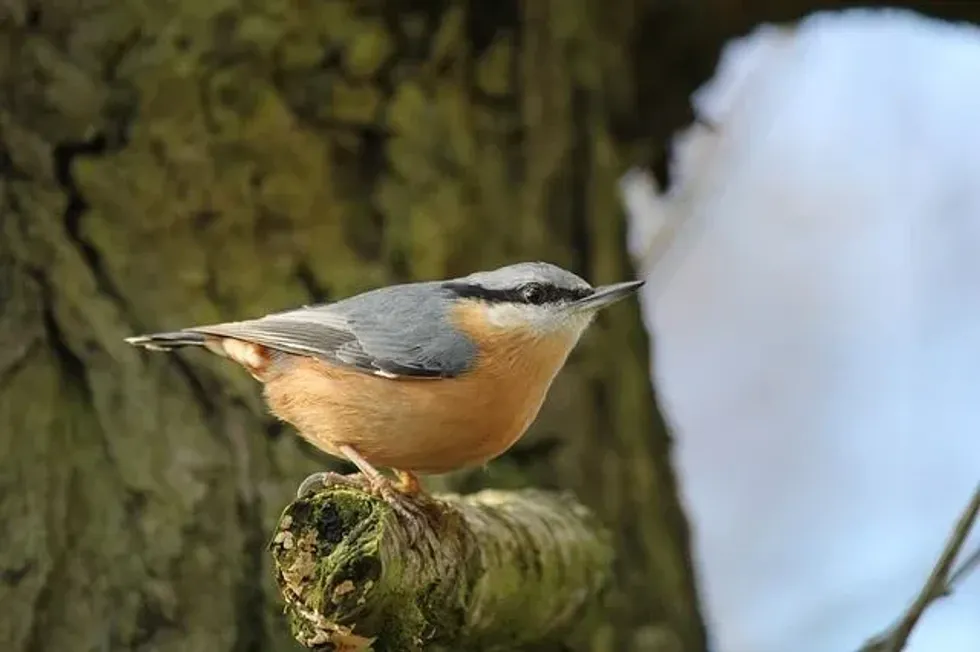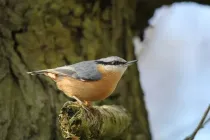The Nuthatch is a small passerine bird with 28 species that looks like a small woodpecker but are not woodpeckers. These birds can grip tree bark and can walk up and down around tree trunks, and also hang upside down on the undersides of tree limbs while foraging for insects and seeds.
They're sometimes referred to as 'upside-down birds' because of these abilities.
Most of the Nuthatch's habitat is in the temperate or montane woodlands of the Northern Hemisphere. The Nuthatch nest is made in holes or crevices of tree trunks, except two species, the Western Nuthatch and Eastern Nuthatch, which habitat in rocky areas.
The White-breasted Nuthatch is a common bird in deciduous and dense forests, while Red-breasted Nuthatch prefers spruce and fir trees. The Brown-headed Nuthatch and Pygmy Nuthatch are found in pine forests of western North America; they are found at average elevations where Ponderosa pine tree grows but can sometimes be found at elevations of 10,000 ft.
The Corsican Nuthatch is a member of the Canadensis group, which includes the Red-breasted Nuthatch, Chinese Nuthatch, Krüper's Nuthatch, and Algerian Nuthatch.
Except for the Algerian Nuthatch, all of these species excavate their nests. Read on for a Nuthatch bird guide to amazing facts about this species.
Do check out our other interesting articles like chinstrap penguin and shoebill facts too.
Nuthatch Interesting Facts
What type of animal is a nuthatch?
The Nuthatches belong to the genus Sitta, which belongs to the Sittidae family, and are small passerine birds with melodious sounds.
What class of animal does a nuthatch belong to?
Nuthatches are warm-blooded vertebrates that belong to the Aves class.
How many nuthatches are there in the world?
Except for South America, Africa, and Antarctica, approximately 27 species of Nuthatches are found on all continents. Red-breasted Nuthatch (Sitta canadensis) and White-breasted Nuthatch (Sitta carolinensis) are well-known North American species.
Both the Eurasian Nuthatch and the North American birds have large populations and extensive ranges. Whereas the White-browed Nuthatch is endangered and can only be found in Burma's Mount Victoria area, where just roughly 12,000 live in the Natma Taung national park.
The White-browed Nuthatch population is also estimated to be only a few thousand individuals and is shrinking. The Algerian Nuthatch will only be found in four areas of Algeria, and the total population might not even exceed 1,000 birds.
Where does a nuthatch live?
The majority of Nuthatches are forest birds that clamber up and down the trees looking for bugs in the bark. These birds prefer nesting in tree trunks' crevices or abandoned woodpecker holes.
Nuthatches have chisel-like, sturdy pointed bills for chipping out nests in trees, and these birds are also excellent woodcarvers like woodpeckers. White-breasted Nuthatches use nest boxes and reuse their nest cavity in subsequent years, whereas Red-breasted Nuthatches excavate their nest cavity.
What is a nuthatch's habitat?
Most of these birds are found in the Northern Hemisphere's woodlands of the mountain; however, two species have adapted to warmer, drier rocky habitats in the regions of Eurasia. All these birds nest in holes or crevices.
The majority of species are non-migratory and live in their habitat all year, except the North American Red-breasted Nuthatches, which migrate to warmer regions during the winter.
Who do nuthatches live with?
When breeding, they forage within their territories, but they may join mixed-species foraging flocks in their habitat at other times. White-breasted Nuthatches are the largest and most commonly seen Nuthatches in North America that live in forests and open areas where food like seeds and nuts are available.
In winter, White-breasted Nuthatches will often forage together with other birds to make more food available and keep an eye out for predators.
How long does a nuthatch live?
The average Nuthatch lifespan is between 2-3.5 years in the wild. According to one research, White-breasted Nuthatches (Sitta carolinensis) have a shorter lifespan than Red-breasted Nuthatches (Sitta canadensis).
How do they reproduce?
Nuthatches are monogamous mates with the same partner for a lifetime. The females lay two clutches of 4-13 eggs with white with red or yellow markings.
Depending upon the species, the size of the egg varies, and these eggs are incubated for 12-18 days by both male and female parents or females alone. It takes about 21-27 days for the altricial chicks to fledge.
The young chicks are fed by both male and female parents.
In the case of two North American species, the Brown-headed Nuthatch (Sitta pusilla) and Pygmy Nuthatch (Sitta pygmaea), a helper male assist their parents by being bird feeders to their siblings. The White-breasted Nuthatch eggs are about 0.7-0.8 in (1.8-2 cm) in length and 0.6 in (1.5 cm) in width.
What is their conservation status?
Deforestation is a significant reason for this bird's population decline. Since White-breasted Nuthatches are larger and more common than other bird species, they are classified as Least Concern.
The population of the Red-Breasted Nuthatch range increased drastically from 1966 and 2014, bringing it into Least Concern species. Some birds, such as the White-browed Nuthatch, Algerian Nuthatch, Yunnan Nuthatch, and Yellow Nuthatch, have become endangered due to excessive pruning or trees' felling.
Nuthatch Fun Facts
What do nuthatches look like?
Nuthatches are small birds with short legs, compressed wings, and 12-feathered short tails. They have stout bills with pointed tips and strong toes with long claws.
The majority of species have gray or bluish upper parts and a black eye stripe. Depending upon species, head markings vary between species but have a common dark forehead and blackish cap. The heads of White-breasted Nuthatches have black crowns, white cheeks, and white undersides that can quickly identify with their long beaks.
The White-breasted Nuthatch resembles the White-cheeked Nuthatch in appearance and contact calls. A Chinese Nuthatch bird is distinguished by an ill-defined eye stripe, duller underparts, and the absence of a diagonal white subterminal band on the tail.

How cute are they?
The Nuthatch being gray on top with a long, black eyestripe, white cheeks, and a rust-colored belly looks very cute and adorable.
How do they communicate?
Nuthatches communicate via vocals. The Nuthatch sound includes whistles, trills, and calls. A Nuthatch bird song has repeated 'whi's.'
A Nuthatch's call includes detailed 'inh' notes. The Brown-headed Nuthatch call is louder and sounds very similar to a rubber duck toy. The Red-breasted Nuthatch call is high-pitched, nasal, and weak. They've been compared to a toy tin horn or a child's noisemaker.
The Pygmy Nuthatch song lasts more than two minutes and is a continuous repetition of its 'piping' call. The White-breasted Nuthatches rarely stray from their mate and maintains constant vocal contact. If you love to listen to these birds' melodic calls and songs, you can find them on the Cornell Lab of Ornithology website.
How big is a nuthatch?
The largest bird is the Giant Nuthatch, which measures 7.7 in (195 mm) in length. In contrast, the Brown-headed Nuthatch and the Pygmy Nuthatch are the world's smallest Nuthatches, which measures 3.9 in (100 mm) in length. These two species, in particular, are usually smaller than sparrows.
How fast can a nuthatch fly?
These birds' exact flying speed is unknown; however, these birds are usually found communally roosting with other birds. White-breasted Nuthatches are commonly found roosting with Chickadees, so their speed could be parallel as 12-13 mph.
How much does a nuthatch weigh?
The weight of these birds ranges from 0.4-1.7oz (10-47g).
What are their male and female names of the species?
Like other birds, the majority of male birds are referred to as cocks, while the majority of female birds are referred to as hens. Compared to male White-breasted Nuthatches, the White-breasted Nuthatch female has a gray crown and paler rusty underparts. The Blue Nuthatch lacks sexual dimorphism and has a striking coloration that distinguishes it from other genus members.
What would you call a baby nuthatch?
The baby birds come out once the eggs hatch and are known as altricial chicks, which are underdeveloped. Later the juvenile Nuthatch is formed, and these young birds rarely stray far from where they hatched.
What do they eat?
The Nuthatch diet relies on live prey like insects and another invertebrate during the breeding season.
But during the winter, most of these birds eat seeds as living prey are not primarily available. These birds wedge their food like the big insects, snails, seeds into cracks of tree trunks and pound with the bird's strong bill.
All these birds often store seeds in tree crevices, or behind bark flakes or inside the ground, or under small stones, and remember them for at least 30 days.
White-breasted Nuthatches primarily consume various types of insects, including larvae. They also consume seeds and nuts such as acorns, hawthorn, and sunflower seeds and occasionally consume a corn crop.
These North American birds eat sunflower seeds, peanuts, suet, and peanut butter from birdfeeders.
A Brown-headed Nuthatch bird uses a piece of tree bark as a lever to pull the rest of the bark crevices in search of food; the bark tool is then carried from one tree to other or also used to cover a seed cache. Similarly, the Rock Nuthatches store insects like snails into tree cavities for later consumption.
They find insects hidden in the bark because of their ability to eat upside down that other birds such as Woodpeckers might overlook as they can travel only up but not down trees.
Are they friendly?
Nuthatches are frequent feeder visitors. Breasted White Nuthatches are common feeder birds found in North America. When they land at bird feeders, they almost always land with their heads down or immediately turn in that direction.
When we come across an orphaned Nuthatch, we must provide a nestbox. They can be fed large nuts such as sunflower seeds and peanuts. The White-breasted Nuthatch seems to be friendly and quite accepts humans.
Would they make a good pet?
Like other birds, Nuthatches are flocking creatures; they are accustomed to having companions at all times.
A bird in its cage can be relatively easy to care for, but a lonely bird will crave companionship just as much as we do.
It is unusual to find one of these birds nesting in your backyard. Even if you find some, you may want to get rid of them by placing objects in the shape of their predators, such as accipiters, owls, squirrels, and woodpeckers, as they can be noisy and messy.
Use shiny, reflective objects; the reflection of these objects discourages birds from nesting in that area, and a bird spike can make them feel uneasy and cause them to avoid landing in that area.
Did you know...
Many birds are hunted for food by the Lotha Naga people, but the Velvet-fronted Nuthatch is generally forbidden because it is believed that killing them will bring misfortune to the hunter.
What are some other names for a nuthatch?
It got its name as Nuthatch with the unique method of fitting their food like seed and nuts into crevices then opening it by hammering it with their strong bills. Nuthatch birds are also called mud dabbler and mud stopper, as they plaster mud around the entrance hole of its nest.
What is the average traveling distance of a nuthatch?
An adult bird travels less than a kilometer on average. These birds are extremely territorial birds unlikely to move far away once established in a particular area. In any struggle for territorial rights, they frequently display significant aggression against the same and other species.
Here at Kidadl, we have carefully created lots of interesting family-friendly animal facts for everyone to discover! Learn more about some other birds including Caspian tern, or robin.
You can even occupy yourself at home by drawing one on our Nuthatch coloring pages.









